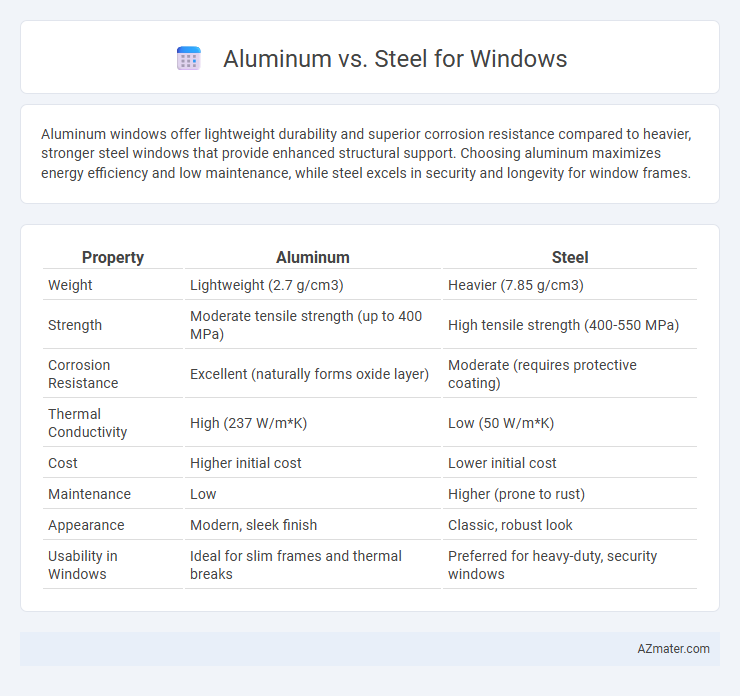Aluminum windows offer lightweight durability and superior corrosion resistance compared to heavier, stronger steel windows that provide enhanced structural support. Choosing aluminum maximizes energy efficiency and low maintenance, while steel excels in security and longevity for window frames.
Table of Comparison
| Property | Aluminum | Steel |
|---|---|---|
| Weight | Lightweight (2.7 g/cm3) | Heavier (7.85 g/cm3) |
| Strength | Moderate tensile strength (up to 400 MPa) | High tensile strength (400-550 MPa) |
| Corrosion Resistance | Excellent (naturally forms oxide layer) | Moderate (requires protective coating) |
| Thermal Conductivity | High (237 W/m*K) | Low (50 W/m*K) |
| Cost | Higher initial cost | Lower initial cost |
| Maintenance | Low | Higher (prone to rust) |
| Appearance | Modern, sleek finish | Classic, robust look |
| Usability in Windows | Ideal for slim frames and thermal breaks | Preferred for heavy-duty, security windows |
Introduction: Aluminum vs Steel for Window Frames
Aluminum window frames offer lightweight durability, corrosion resistance, and design flexibility, making them ideal for modern architectural styles and energy-efficient applications. Steel window frames provide superior strength, security, and longevity, often preferred in industrial and historic restorations requiring robust structural support. Choosing between aluminum and steel depends on factors like budget, maintenance, thermal performance, and aesthetic preferences for window installations.
Material Properties: Aluminum and Steel Compared
Aluminum offers superior corrosion resistance and lightweight properties, making it ideal for window frames exposed to moisture and requiring ease of installation. Steel provides exceptional strength and durability, supporting larger window spans and increased security but tends to be heavier and prone to rust without proper coatings. The choice between aluminum and steel hinges on balancing corrosion resistance, structural strength, and maintenance needs for specific window applications.
Durability and Strength in Window Applications
Aluminum windows offer high resistance to corrosion and require minimal maintenance, making them durable in various weather conditions. Steel windows provide superior strength and impact resistance, enhancing security and structural support in heavy-duty applications. Both materials deliver long-lasting performance, but steel's higher tensile strength offers better endurance in extreme environments.
Thermal Performance: Insulation and Energy Efficiency
Aluminum windows typically have lower thermal performance compared to steel due to aluminum's high thermal conductivity, which can lead to increased heat transfer and reduced insulation. Steel windows can offer better strength but often require thermal breaks or additional insulation layers to improve energy efficiency and minimize heat loss. Upgraded aluminum frames with thermal breaks and insulated glazing often outperform standard steel windows in thermal insulation for modern energy-efficient designs.
Corrosion Resistance: Longevity in Different Climates
Aluminum windows offer superior corrosion resistance compared to steel, making them ideal for coastal and humid climates where salt and moisture accelerate rust formation. Steel windows, while stronger, require protective coatings and regular maintenance to prevent corrosion and extend longevity, especially in wet or industrial environments. Investing in aluminum ensures longer-lasting window frames with minimal degradation regardless of climate variability.
Maintenance Requirements for Aluminum and Steel Windows
Aluminum windows require minimal maintenance due to their resistance to rust, corrosion, and fading, often needing only occasional cleaning with mild detergent and water. Steel windows demand more upkeep, including regular inspection for rust, application of protective coatings, and timely repainting to prevent corrosion. Choosing aluminum can reduce long-term maintenance costs, whereas steel provides strength but necessitates vigilant care to maintain durability.
Aesthetic Options and Design Flexibility
Aluminum windows offer superior design flexibility due to their lightweight structure, allowing for slimmer frames and larger glass panes that enhance natural light and modern aesthetics. Steel windows provide a classic, industrial look with exceptional strength, enabling intricate designs and thinner profiles while supporting heavier glass options. Both materials deliver diverse aesthetic options, but aluminum excels in contemporary, minimalistic styles whereas steel suits historical or architectural projects requiring robustness and ornate details.
Cost Comparison: Aluminum vs Steel Windows
Aluminum windows generally cost less than steel windows due to lower material and manufacturing expenses. Steel windows offer higher strength and durability but come with a higher price tag, often 20-30% more than aluminum options. Maintenance costs for aluminum windows are typically lower, as steel can require more frequent painting and rust prevention treatments over time.
Environmental Impact and Sustainability
Aluminum windows offer superior recyclability, as aluminum can be recycled indefinitely with minimal loss of quality, reducing reliance on raw material extraction and lowering overall environmental impact. Steel windows, while also recyclable, require more energy-intensive production processes resulting in higher carbon emissions compared to aluminum. Choosing aluminum frames contributes to sustainable building practices due to their lightweight nature, durability, and lower embodied energy throughout the product lifecycle.
Choosing the Right Material for Your Windows
Aluminum windows offer superior corrosion resistance and a sleek, modern aesthetic, making them ideal for contemporary designs and coastal climates. Steel windows provide exceptional strength and security with a classic, industrial appeal, often preferred for historic renovations or heavy-duty applications. Selecting the right material depends on factors like durability requirements, maintenance preferences, climate exposure, and overall architectural style.

Infographic: Aluminum vs Steel for Window
 azmater.com
azmater.com